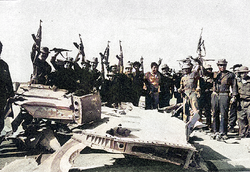Salamati-Khirmanian war
The Salamati-Khirmanian is a two-week war which opposed the countries of Salamat, led by Jalil Al Kharrabi and Khirmania, led by King Agbayu.
Background
Although the relations between Khirmania and Salamat were hostile, tensions grew rapidly when a military coup installed Jalil Al Kharrabi who was a staunch islamist, as opposed to Khirmania's government.
Opposing forces
Khirmania
The Holy State of Khirmania is ruled by a theocratic monarchy since independence.
By the time the war started, Khirmania was considered one of the biggest players in the region and had a well-equipped and well-trained army, so it came as a surprise to many how the Salamati Army managed to cross the border and invade Khirmania.
Salamat
Salamat was an authoritarian dictatorship ruled by the Mushir (Field Marshal) Jalil Al Kharrabi.
In the preceding years, Salamat had developed strong diplomatic ties with the communist country of Ezenchia, which granted him trade deals, including military equipment. At the same time, Salamat started developing its own indigenous military industry, although most of the weapons produced by Salamat at that time were pure copies of Riamese vehicles and weapons.
War
Invasion and offensive in Khirmania
At 0500 hours on July 3 1985, motorized vehicles, tanks and infantry crossed the border as a part of "Operation Hisan", which consisted of capturing the city of Al Hisan, also known as Isang, near the border.
The 8th infantry brigade and the 3rd division, however, were aiming for the coastal city of Baluang, which hosts a major port, making it an useful target.
The Salamati officers considered going on an all-in offensive on Mukarda, the Khirmanian capital, but the local geography would've made it difficult for the Salamati motorized formations to attain the capital.
At 1800 hours on July 4 1985, the Salamati and Khirmanian engaged in the first battle of the war, being the battle of the Ipan, named after the river bed which was disputed between the Salamati 1st division and the Khirmanian 7th brigade. Artillery shelling by the Salamati caused considerable damage to the city of Ipan, located 0,7 km (0,43 mi) northeast of the battlefield, and killed 11 civilians. Khirmanian artillery shelling, however, killed an estimated 150 soldiers in 6 hours. The battle would continue until a breach appeared in the Khirmanian frontline, forcing them to retreat north. At 0235 hours on July 5, the battle was a confirmed Salamati victory.
The Salamati troops in the south faced considerable resistance near Baluang, forcing them to retreat northward in the morning of July 5 1985.
Another battle emerged at 1300 hours on the same day, near the city of Al Hisan, in one of its suburbs named Bukilog, when the 17th armored battalion of Salamat encountered the 8th infantry battalion of Khirmania. This was the start of the battle of Bukilog.
Quickly, Khirmanian troops came to support the battalion, while Salamati troops were shelling the city from a field 0.9 km (0.56 mi) southwest of Bukilog. At 1440 hours, buildings of Bukilog started taking fire, and some Khirmanian troops were forced to retreat. Shortly after, Salamati troops advanced into the city, oddly with no resistance. At the same time, the Khirmanian encircled the city, and attempted an ambush, which failed. The battle evolved in an urban showdown, with troops hiding in houses and tanks driving in the streets of Bukilog. A group of Khirmanians then deserted, considering that the battle was long lost. Then, another Salamati battalion arrived as a support at 2100 hours, and stormed the city, cleaning it of most Khirmanian troops. The rest were forced to surrender, except TBA, which still remains as a symbol in Khirmania today.
At 0230 hours on July 6 , the battle was officially over and the Salamati won the battle of Bukilog.
On July 6, the Salamati advance began to slow down, with more resistance being encountered in the interior of the country. At 1200 hours on July 6, the Salamatis were only at 8 km from Al Hisan, and 32 km from Mukarda, the capital.
At dawn on July 7, Khirmanian troops began attacking Salamati troops that were advancing near Al Hisan, eventually starting the battle of Isang. Isang, being crossed by a river from the northwest to the southeast, was divided between Salamatis and Khirmanians, with crossings of the river only possible by bridges, which were destroyed at noon on July 7, after an attempted incursion by the Salamatis. The Salamatis and Khirmanians would eventually end up using artillery and shell eachother's positions for hours continously. Some soldiers on the Khirmanian side attempted to cross the river to launch an attack, but were victims of Salamati fire, forcing them to retreat. However, as it was the dry season, the river was drying up, which was a normal case during the months of July and August, and at 2000 hours on July 9, a large mass of Khirmanian soldiers crossed the nearly-empty river, and launched an attack in west Isang. Shortly after, the Salamatis were forced to retreat west into the suburb city of Kapakayo. The battle of Isang became the first battle won by the Khirmanians in the war.
Reversal of trends
After the defeat in Isang, some of the troops were demoralized and a fraction defected of the army. At the same time, the Khirmanians elaborated a counteroffensive, aiming to capture Dar Al Hamma, which is the capital city of Salamat.
On July 9, the Khirmanians started a major offensive all over the front, the goal being to drive the Salamatis back at the border, or even at Dar Al Hamma for some experts. At noon, a major battle started in the Malada peninsula, a peninsula on the east side of the Al Mujarrif bay, close to the border. The Khirmanian forces swarmed the city of Malada, which was lightly occupied by the Salamatis. The small group of Salamatis present defended the city, which was useful to recieve supplies. Was ensued a battle of 2,000 against 120, which lasted until 0000 hours July 10, when most of the Salamatis were killed and the rest was forced to surrender.
At 1700 hours on July 11, the first Khirmanian troops set foot on Salamati soil, which marks the start of the Khirmanian counteroffensive.
Khirmanian counteroffensive : Road to Dar Al Hamma
The Khirmanian quickly stormed the fareastern parts of Salamat in the early hours of July 12, but these regions being of little importance, both economically and militarily, they were not the focus of the Khirmanians, whose focus was on the Bani Dasser Airbase. At the same time, Khirmanian troops in the south entered Salamat, but faced much more resistance, being largely inhabited and of great importance. The Salamati aviation also raided Mukarda at 0700 hours, while the Khirmanians were pushing the Salamatis in Al Mujarrif, close to the border.
The first battle of the counteroffensive was the battle of Al Mujarrif, which started at 1000 hours on July 13 and named after the city of the same name. During the battle, the Khirmanians tried to storm the city center, but were constantly pushed out by the Salamati infantry and artillery, before successfully entering and controlling the city center at sunset, and forcing the Salamatis to retreat westward and into the Al Mujarrif Military Airport, which was later captured by the Khirmanians at 1500 hours on July 14, after intense shelling by the Khirmanians.
The morale of the Salamatis after this battle was extremely low, and the regime of Al Kharrabi used propaganda to uphold the soldiers.
The Khirmanians also tried to capture the major city of Douara as a part of "Operation Hamma" during the Battle of Douara in the morning and afternoon of July 14, but failed to do so. The Khirmanians were then forced to retreat in the Thalathi hills east and northeast of Douara.
On July 16, the Khirmanians attempted to storm all of the southern front to accelerate the capture of Dar Al Hamma. The operation was a success in some sectors, like the sector of Mansujah, where the Salamatis were forced to retreat from the region due to the intensive shelling of the city, which damaged 60% of the city. However, it was a failure in the Douara region, where the Khirmanians were forced to retreat as far as Dar Al Janub, after a counteroffensive of the Salamati forces.
During the last days of the war, the Khirmanians were opposed to a strong resistance on the vast majority of the front, eventually turning into a stalemate. The Salamatis morale was extremely low, with hundreds of defectors joining the Khirmanian ranks or fleeing abroad (Example with a group of five soldiers which stole a boat and arrived in Kakland). The Khirmanian were also suffering from low morale, but the defection cases were rare. One of Salamat's top officers, Tariq Qashari, was killed on July 18 near the border during a siege.
On July 20, Jalil Al Kharrabi and TBA agreed to meet to cease the war. A cease-fire was put in place from 0100 hours July 21 until the end of the conflict.
At 1147 hours on July 21 1985, the war was officially ended with the Mukarda Armistice.
Aftermath
Jalil Al Kharrabi faced anger from both the international community and its own people. Salamat also suffered from heavy military losses and an economic decrease as a result of destroyed infrastructures. Al Mujarrif and Mansujah were partially destroyed and a colossal sum of money was used to rebuild both cities.
At the same time, Salamat was obligated to pay war reparations to Khirmania, and the borders were returned to their prewar status. Salamati defectors were executed and four years later, the Bloody Moon Purge took place, killing two officers which were designated as the "cause" of the defeat.

